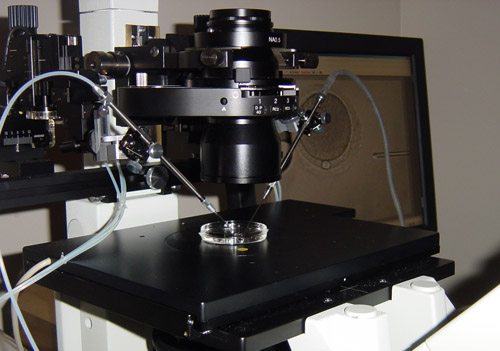Why and How is Intracytoplasmic Sperm Injection ICSI used?
Intracytoplasmic sperm injection (ICSI) is part of the in vitro fertilization (IVF) stage of the assisted reproductive technology (ART) process, in which a single best-selected sperm is injected directly into an egg.
Hyaluronidase removes the cells surrounding the egg, then embryologyst places the washed sperm in a cup in a thick, viscous medium containing polyvinylpyrrolidone.
Then the best spermatozoa are selected and a mature oocyte is taken, the inner part of the oocyte is pierced from the opposite side with a thin glass needle and the selected spermatozoon is launched there.
After the procedure, the oocyte is placed in a cell culture, and after 12 hours it is checked for signs of fertilization.
This is how fertilization occurs.
Male infertility is the most common reason for using intracytoplasmic sperm injection (ICSI).
Intracytoplasmic Sperm Injection (ICSI): A Revolutionary Approach to Fertility Treatment
Introduction:
ICSI is a powerful and highly specialized assisted reproductive technology technique used to address male infertility. Unlike traditional in vitro fertilization (IVF), where sperm and eggs are combined in a dish and left to fertilize on their own, ICSI takes a more direct and targeted approach.
Why ICSI is Used:
ICSI is primarily employed in cases of male infertility, where the sperm may have difficulty penetrating the egg naturally. This could be due to low sperm count, poor sperm motility, or abnormalities in sperm shape (morphology). ICSI is particularly beneficial when standard IVF procedures might be less effective in achieving fertilization.
How ICSI Works:
- Ovulation Stimulation: The female partner undergoes ovarian stimulation to produce multiple eggs.
- Egg Retrieval: Once the eggs are mature, they are retrieved from the ovaries through a minor surgical procedure.
- Sperm Collection: A sperm sample is collected from the male partner or a sperm donor.
- Microscopic Injection: Under a high-powered microscope, a single, healthy sperm is selected and injected directly into the cytoplasm of a mature egg. This precise injection ensures fertilization takes place even when there are challenges with natural sperm-egg interaction.
- Embryo Culture: After successful fertilization, the embryos are cultured in the laboratory for a few days.
- Embryo Transfer: One or more viable embryos are selected and transferred to the woman’s uterus.
Advantages of ICSI:
- Overcoming Male Infertility: ICSI is a breakthrough for couples dealing with severe male fertility issues.
- Increased Fertilization Rates: ICSI has significantly higher fertilization rates compared to traditional IVF.
- Genetic Testing Possibilities: ICSI allows for preimplantation genetic testing (PGT), where embryos are screened for genetic abnormalities before being implanted.
In conclusion, ICSI has emerged as a groundbreaking technique of assisted reproductive technologies, offering hope to couples facing male fertility. Its precision and effectiveness in achieving fertilization underscore its significance in the ever-evolving landscape of fertility treatments.
A protein that plays an important role in male fertility
What is surrogacy and sperm, egg and embryo donation?
How in vitro fertilization (IVF) helps in the fight against infertility


